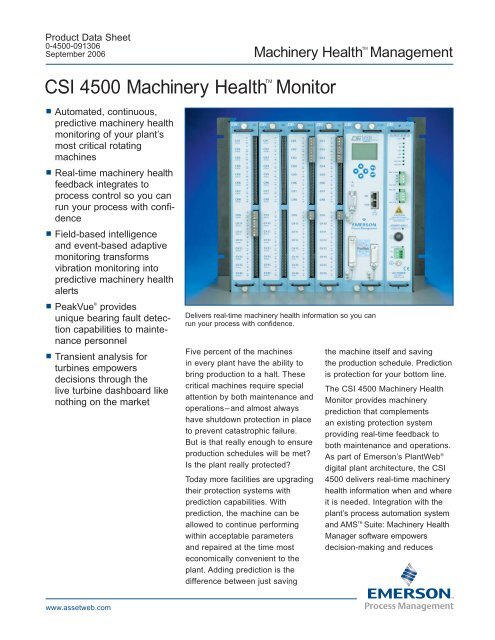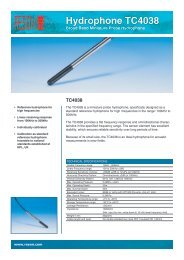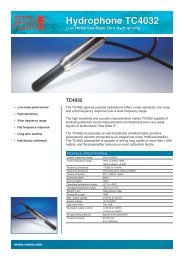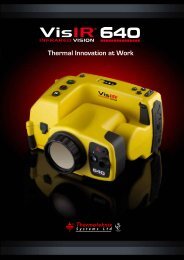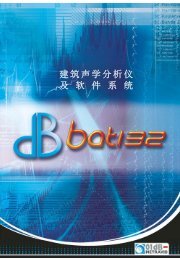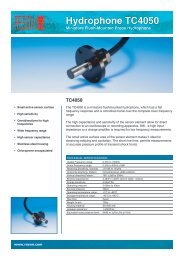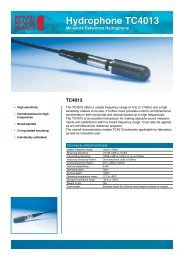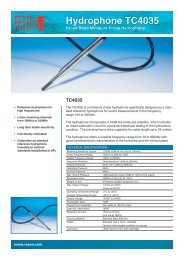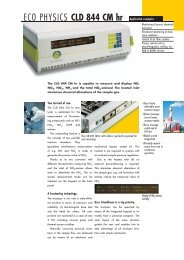CSI 4500 Machinery HealthTM Monitor
CSI 4500 Machinery HealthTM Monitor
CSI 4500 Machinery HealthTM Monitor
Create successful ePaper yourself
Turn your PDF publications into a flip-book with our unique Google optimized e-Paper software.
Product Data Sheet<br />
0-<strong>4500</strong>-091306<br />
September 2006<br />
<strong>Machinery</strong> Health TM Management<br />
<strong>CSI</strong> <strong>4500</strong> <strong>Machinery</strong> Health TM <strong>Monitor</strong><br />
n Automated, continuous,<br />
predictive machinery health<br />
monitoring of your plant’s<br />
most critical rotating<br />
machines<br />
n Real-time machinery health<br />
feedback integrates to<br />
process control so you can<br />
run your process with confidence<br />
n Field-based intelligence<br />
and event-based adaptive<br />
monitoring transforms<br />
vibration monitoring into<br />
predictive machinery health<br />
alerts<br />
n PeakVue ® provides<br />
unique bearing fault detection<br />
capabilities to maintenance<br />
personnel<br />
n Transient analysis for<br />
turbines empowers<br />
decisions through the<br />
live turbine dashboard like<br />
nothing on the market<br />
Delivers real-time machinery health information so you can<br />
run your process with confidence.<br />
Five percent of the machines<br />
in every plant have the ability to<br />
bring production to a halt. These<br />
critical machines require special<br />
attention by both maintenance and<br />
operations–and almost always<br />
have shutdown protection in place<br />
to prevent catastrophic failure.<br />
But is that really enough to ensure<br />
production schedules will be met?<br />
Is the plant really protected?<br />
Today more facilities are upgrading<br />
their protection systems with<br />
prediction capabilities. With<br />
prediction, the machine can be<br />
allowed to continue performing<br />
within acceptable parameters<br />
and repaired at the time most<br />
economically convenient to the<br />
plant. Adding prediction is the<br />
difference between just saving<br />
the machine itself and saving<br />
the production schedule. Prediction<br />
is protection for your bottom line.<br />
The <strong>CSI</strong> <strong>4500</strong> <strong>Machinery</strong> Health<br />
<strong>Monitor</strong> provides machinery<br />
prediction that complements<br />
an existing protection system<br />
providing real-time feedback to<br />
both maintenance and operations.<br />
As part of Emerson’s PlantWeb ®<br />
digital plant architecture, the <strong>CSI</strong><br />
<strong>4500</strong> delivers real-time machinery<br />
health information when and where<br />
it is needed. Integration with the<br />
plant’s process automation system<br />
and AMS Suite: <strong>Machinery</strong> Health<br />
Manager software empowers<br />
decision-making and reduces<br />
www.assetweb.com
Product Data Sheet<br />
September 2006<br />
machinery health faults. When<br />
both prediction and protection are<br />
required, Emerson delivers with<br />
a complete asset management<br />
strategy for your most critical<br />
rotating machines.<br />
PlantWeb Alerts give clear, powerful indications of developing problems to an<br />
operator at a DeltaV station.<br />
Real-time <strong>Machinery</strong> Health<br />
Feedback to Process<br />
Automation<br />
<strong>Machinery</strong> health information<br />
is nothing new–maintenance<br />
personnel have long benefited<br />
from the predictive capabilities<br />
of vibration analysis and other<br />
integrated technologies. But<br />
without vibration monitoring<br />
feedback to process automation,<br />
operators don’t know the effects<br />
their actions have on the health<br />
of rotating machines. In fact,<br />
40% of machine faults are the<br />
result of process variations.<br />
The <strong>CSI</strong> <strong>4500</strong> and the AMS<br />
<strong>Machinery</strong> Manager send real-time<br />
overall vibration levels to operators.<br />
If process adjustments are<br />
made, operators see the live<br />
impact on machinery health. With<br />
vibration data integrated with<br />
process automation, informed<br />
real-time decisions are possible.<br />
For example, if a mill operator<br />
adjusts a stretch roll on the paper<br />
machine and cocks the roll, vibration<br />
increases immediately.<br />
Feedback to the operator is provided<br />
and further adjustments<br />
head-off premature failure of the<br />
roll.<br />
The <strong>CSI</strong> <strong>4500</strong> provides machinery prediction that complements an<br />
existing protection system.<br />
Page 2
<strong>Machinery</strong> Health TM Management<br />
PlantWeb Alerts provide<br />
actionable information.<br />
There are certain process variations<br />
that impact rotating machines in<br />
negative ways. For instance, low<br />
tank or head levels may increasevibration<br />
on a pump or hydro<br />
turbine. Faulty valves, incorrect<br />
process running conditions,<br />
upstream loads or downstream<br />
backups may also impact<br />
machinery health.<br />
Process event monitoring with<br />
adaptive automated vibration<br />
analysis will send PlantWeb Alerts,<br />
containing information about the<br />
fault, to operators at Emerson’s<br />
DeltaV digital automation system.<br />
As an example, when a tank level<br />
sensor indicates the level has<br />
exceeded a designated low set<br />
point, the <strong>CSI</strong> <strong>4500</strong> detects and<br />
automatically adapts its monitoring<br />
strategy to begin “watching” for a<br />
cavitation parameter to exceed a<br />
defined fault level. A PlantWeb<br />
Alert labeled cavitation is then<br />
delivered to the operator at the<br />
DeltaV station. The operator can<br />
take action such as adjusting the<br />
level of an upstream tank to<br />
decrease vibration and increase<br />
efficiency on a pump, adjusting<br />
tank levels<br />
to stop cavitations, or increasing<br />
speed of a machine to eliminate<br />
a resonance condition.<br />
<strong>Machinery</strong> Health feedback integrates to process automation systems,<br />
such as Emerson’s Ovation ® and DeltaV digital automation systems.<br />
Page 3
Product Data Sheet<br />
September 2006<br />
Calendar rolls, winders, nip rolls, vacuum rolls, and changing machine speeds<br />
require event-based adaptive monitoring.<br />
Information for fast,<br />
accurate decision-making.<br />
As plant personnel go about their<br />
daily activities, the <strong>CSI</strong> <strong>4500</strong>’s<br />
built in, exception-based processor<br />
collects and distributes information<br />
to the right system or user<br />
only when machinery health<br />
changes. The <strong>CSI</strong> <strong>4500</strong> continuously<br />
monitors the health of your<br />
machine, but sends alerts or new<br />
trend data to Emerson’s DeltaV or<br />
Ovation automation system on an<br />
exception basis when health<br />
changes. In addition, the <strong>CSI</strong><br />
<strong>4500</strong> and the AMS <strong>Machinery</strong><br />
Manager with the GT2 processor<br />
option can deliver transient analysis<br />
and live views specifically<br />
designed for large<br />
and critical turbo machinery.<br />
AMS <strong>Machinery</strong> Manager also<br />
integrates with AMS Suite:<br />
Asset Portal where machine<br />
health is combined with other<br />
asset condition and performance<br />
information for a plant-wide view.<br />
Event-based monitoring<br />
links vibration information<br />
to process states.<br />
A machine that is in its normal<br />
operating mode, or production<br />
state, is far from operating in a<br />
steady state" condition. With other<br />
monitoring systems, an increasing<br />
load means increasing vibration<br />
levels and false alarms. This can<br />
necessitate setting vibration<br />
alarms extremely high to account<br />
for all process scenarios or events.<br />
Much like a process automation<br />
system, the <strong>CSI</strong> <strong>4500</strong>'s built-in<br />
Production State processor more<br />
accurately monitors process events<br />
such as speed inputs, changing<br />
load, temperature, tank level or<br />
relay closures. The <strong>CSI</strong> <strong>4500</strong><br />
<strong>Machinery</strong> Health <strong>Monitor</strong> processes<br />
events, adapts its monitoring,<br />
and produces a real alarm when<br />
machine health changes versus a<br />
false alarm when the load changes.<br />
Alarms are much tighter and false<br />
alarms are decreased. This adaptive<br />
strategy is not limited to adjusting<br />
alert levels; analysis types and<br />
the frequency of analysis can automatically<br />
be adapted as well.<br />
Page 4
<strong>Machinery</strong> Health TM Management<br />
Through AMS Suite: <strong>Machinery</strong> Health Manager, the PeakVue technology allows<br />
clear spikes to poke through the noise floor providing early fault<br />
detection of a Yankee dryer gearbox.<br />
Predictive <strong>Machinery</strong> Health<br />
<strong>Monitor</strong>ing for<br />
Early Warning and Planning<br />
for the Maintenance<br />
Department<br />
Exception-based reporting<br />
drives you to the problem and<br />
reduces troubleshooting time<br />
Exception-based reporting allows<br />
the <strong>CSI</strong> <strong>4500</strong> to keep a close<br />
watch on the assets, but only<br />
alert your maintenance staff<br />
when the machine health<br />
changes. Exception-based<br />
reporting produces specific alerts<br />
and decreases the amount of data<br />
required for review when it is time<br />
to troubleshoot the alert. With<br />
the <strong>CSI</strong> <strong>4500</strong>, troubleshooting<br />
time can be reduced 90%<br />
through powerful analysis tools<br />
such as transient analysis for<br />
turbines, PeakVue bearing health<br />
technology, and customizable<br />
reporting capabilities.<br />
PeakVue technology is<br />
best-available bearing and<br />
gearbox anomaly detector<br />
PeakVue technology provides<br />
early, accurate and trendable roller<br />
bearing and gearbox anomaly<br />
detection unmatched by all other<br />
bearing health tools on the market.<br />
PeakVue’s patented method of<br />
processing preserves the peak<br />
amplitude of the stress wave<br />
emitted from a bearing or gear<br />
defect. Preserving this peak<br />
amplitude allows trendable<br />
bearing health diagnostics.<br />
Other bearing tools on the market<br />
use demodulation techniques,<br />
which subtract carrier frequencies<br />
and use low pass filters. These<br />
processes have adverse effects on<br />
the original peaks that PeakVue<br />
maintains. If the carrier frequency<br />
during demodulation is amplitude<br />
modulated, then the amplitude of<br />
the resultant bearing energy is<br />
changing and will be less than the<br />
original bearing energy collected.<br />
Furthermore, the amplitude of<br />
the bearing energy after the low<br />
pass filter has been applied,<br />
will increase as the frequency<br />
of the defect increases.<br />
Page 5
Product Data Sheet<br />
September 2006<br />
<strong>CSI</strong> <strong>4500</strong>T Turbine <strong>Monitor</strong><br />
n Live Turbine Dashboard<br />
n 60 hour Data Recorder<br />
n Turbine Replay<br />
n 3D Turbine Graphical<br />
Representation<br />
To illustrate the results from<br />
Emerson’s <strong>Machinery</strong> Health<br />
technologies working together<br />
to provide turbine protection,<br />
here is a short scenario.<br />
The AMS <strong>Machinery</strong> Manager shows live cascade and orbit<br />
plots for visual comparison provided from the GT2 Processor.<br />
scenario<br />
AMS <strong>Machinery</strong> Manager allows users to select<br />
live plots for all bearings simultaneously.<br />
When the Turbine Trips<br />
You are comfortably home for<br />
the evening when the phone rings<br />
and you learn the turbine just<br />
tripped. The decision to restart the<br />
equipment is yours. Although you<br />
feel the pressure, you are confident<br />
because you have two powerful<br />
tools to rely on–all the necessary<br />
data was captured to<br />
assess the event and a live turbine<br />
dashboard will provide assurance<br />
during start-up.Information<br />
before, during and after the turbine<br />
trip is waiting for you. As you<br />
drive to the site, you review the<br />
facts:<br />
1. You have the proper setup to<br />
capture the right data surrounding<br />
the event. With virtually no setup,<br />
you can be assured the right data<br />
and the anomalous event will<br />
be captured.<br />
Data extraction session for post processing events or<br />
baseline comparisons.
<strong>Machinery</strong> Health TM Management<br />
In this scenario, the <strong>CSI</strong> <strong>4500</strong><br />
along with the AMS <strong>Machinery</strong><br />
Manager allowed the user to<br />
easily see the information to make<br />
a confident decision. Emerson’s<br />
predictive technologies, such as<br />
the AMS Suite of applications<br />
and the <strong>CSI</strong> <strong>4500</strong> along with<br />
complementary PlantWeb<br />
Services, allow you to maximize<br />
availability and performance of<br />
key production assets to ensure<br />
operational excellence.<br />
2. Real-time continuous data<br />
recording ensures events will not<br />
be missed. With the <strong>CSI</strong> <strong>4500</strong>,<br />
a 60 hour running history is<br />
recorded all of the time. The<br />
<strong>CSI</strong> <strong>4500</strong>’s continuous data<br />
recorder will record and buffer from<br />
60 hours to over one week,<br />
depending on the number of sensor<br />
inputs. Auto archiving of data<br />
is also included so that small, one<br />
hour, snapshots can be permanently<br />
and automatically saved to<br />
a network server.<br />
3. The live turbine dashboard will<br />
enable real-time decisions during<br />
start up.<br />
When you arrive on site, they have<br />
already found a plugged oil line to<br />
the bearing. Now the question is<br />
“how much damage was done,<br />
and can we restart?”<br />
Multi-channel, continuous data<br />
recording saves you from ever<br />
missing an event and ensures the<br />
right information is available to dig<br />
deeper into the problem. You look<br />
at the quick views and then extract<br />
the region of interest for more<br />
details, which quickly drives you<br />
to your decision.<br />
You review the data, compare with<br />
baseline, and confirm the vibration<br />
is isolated to one bearing. The<br />
shaft centerline plots tell you the<br />
bearing clearance was not exceeded.<br />
After fixing the oil flow issue,<br />
you advise restarting the turbine<br />
as you watch the live turbine dashboard.<br />
The live turbine dashboard provides<br />
real-time decision-making<br />
during start-up.<br />
The live turbine dashboard, available<br />
with the <strong>CSI</strong> <strong>4500</strong> transient<br />
system,provides live plots that<br />
were not possible before the GT2<br />
processor. Live real-time plots<br />
such as overall levels, orbits, shaft<br />
centerline, Bode/ Nyquist, cascade,<br />
waveform and spectrum, on all<br />
bearings, allow a turbine specialist<br />
to make real-time decisions.<br />
Simple Windows displays make<br />
manipulating screens and plots<br />
easy. Dual monitor mode helps<br />
you organize your views<br />
so you are staged for the startup.<br />
You can overlay baseline plots<br />
(from portable or online systems)<br />
on known good start-up plots<br />
to view the differences.<br />
With the transient live turbine<br />
dashboard, you can make realtime<br />
decisions with operators and<br />
production staff to bring the<br />
turbine up for critical production<br />
needs or to shut down again<br />
to save the asset.<br />
Page 7
Product Data Sheet<br />
September 2006<br />
Chassis Options<br />
<strong>CSI</strong> <strong>4500</strong>M <strong>Monitor</strong><br />
The <strong>CSI</strong> <strong>4500</strong>M <strong>Monitor</strong> is the<br />
most common model for applications<br />
in power, refining, oil & gas,<br />
petrochemical, chemical, pulp and<br />
paper, and offshore industries.<br />
The <strong>CSI</strong> <strong>4500</strong>M <strong>Monitor</strong> (with up<br />
to 32 sensor input channels, 16<br />
tachometer input channels and up<br />
to16 relays) offers the best choice<br />
in flexibility and cost per channel.<br />
The <strong>CSI</strong> <strong>4500</strong>M <strong>Monitor</strong> includes<br />
the Trip Advisory <strong>Monitor</strong> for tier 2<br />
critical machines, The Production<br />
State <strong>Monitor</strong> for continually<br />
changing machine operating<br />
states, and is upgradeable to the<br />
<strong>CSI</strong> <strong>4500</strong>T <strong>Monitor</strong>, which<br />
includes transient analysis for turbines.<br />
<strong>CSI</strong> <strong>4500</strong>M <strong>Monitor</strong> with G2 Processor.<br />
For more information visit<br />
http://www.mhm.assetweb.com/technology/online.html<br />
<strong>CSI</strong> <strong>4500</strong>MS <strong>Monitor</strong><br />
The <strong>CSI</strong> <strong>4500</strong>MS ("S" denoting<br />
small rack size) <strong>Monitor</strong> has the<br />
same functionality as the <strong>CSI</strong><br />
<strong>4500</strong>M <strong>Monitor</strong>, but with a smaller<br />
rack footprint of 12 sensor inputs,<br />
2 tachometer inputs, and 2 relays.<br />
The <strong>CSI</strong> <strong>4500</strong>MS <strong>Monitor</strong> is the<br />
best choice for remote machines<br />
or for machine centric monitoring<br />
applications. The <strong>CSI</strong> <strong>4500</strong>MS<br />
<strong>Monitor</strong> is perfect for OEM applications,<br />
or when a machine needs<br />
dedicated monitoring and requires<br />
fewer sensor inputs.The <strong>CSI</strong><br />
<strong>4500</strong>MS is not upgradable to the<br />
transient option.<br />
<strong>CSI</strong> <strong>4500</strong>MS <strong>Monitor</strong> for small channel-count applications.<br />
Page 8
<strong>Machinery</strong> Health TM Management<br />
<strong>CSI</strong> <strong>4500</strong>Q <strong>Monitor</strong><br />
The <strong>CSI</strong> <strong>4500</strong>Q <strong>Monitor</strong><br />
is a Factory Mutual,<br />
Class I Div II, Groups C and D rated<br />
monitor for applications in power,<br />
refining, oil & gas, petrochemical,<br />
chemical, and offshore industries.<br />
The <strong>CSI</strong> <strong>4500</strong>Q <strong>Monitor</strong> (with 32<br />
sensor input channels, 16 tachometer<br />
input channels and 16 relays)<br />
includes the same functionality as<br />
the <strong>CSI</strong> <strong>4500</strong>M -- the Trip Advisory<br />
<strong>Monitor</strong> for balance of plant critical<br />
machines, the Production State<br />
<strong>Monitor</strong> for continually changing<br />
machine operating states, but is not<br />
upgradeable to the <strong>CSI</strong> <strong>4500</strong>T<br />
<strong>Monitor</strong>. The <strong>CSI</strong> <strong>4500</strong>Q <strong>Monitor</strong>'s<br />
only power supply option is the<br />
24VDC source.<br />
<strong>CSI</strong> <strong>4500</strong> <strong>Machinery</strong> Health <strong>Monitor</strong><br />
Enclosure Specifications<br />
PN A<strong>4500</strong>Mx, Where x = 1, 2, 3, 4, 5, 6, 7, 8<br />
PN A<strong>4500</strong>Q<br />
PN A<strong>4500</strong>Tx, Where x = 3, 4, 7, 8<br />
PN A<strong>4500</strong>MS<br />
Overall System Characteristics<br />
Enclosure Dimensions<br />
Environmental for <strong>CSI</strong> <strong>4500</strong>M,<br />
<strong>CSI</strong> <strong>4500</strong>MS, <strong>CSI</strong> <strong>4500</strong>Q<br />
Environmental for <strong>CSI</strong> <strong>4500</strong>T<br />
Ratings<br />
22.25" width x 26.00" height x 11.56" depth<br />
180 o opening required for enclosure door<br />
0 to 110°F (-17 to 43°C); 0 to 120°F (-17 to<br />
48°C) w/ fan tray accessory (PN B<strong>4500</strong>FT)<br />
0 to 95% R.H. noncondensing<br />
0 to 86°F or 0 to 30°C with Fan tray (fan tray<br />
required) <strong>CSI</strong> <strong>4500</strong>T is best suited for<br />
computer room, control room environment<br />
CE EN50081-2 Emissions<br />
CE EN50082-2 Immunity<br />
Ordering Information<br />
x = 1, 16 sensor input, 0 tachometer, 0 relays<br />
x = 2, 32 sensor input, 0 tachometer, 0 relays<br />
x = 3, 16 sensor input, 16 tachometer, 0 relays<br />
x = 4, 32 sensor input, 16 tachometer, 0 relays<br />
x = 5, 16 sensor input, 0 tachometer, 16 relays<br />
x = 6, 32 sensor input, 0 tachometer, 16 relays<br />
x = 7, 16 sensor input, 16 tachometer, 16 relays<br />
x = 8, 32 sensor input, 16 tachometer, 16 relays<br />
Page 9
Product Data Sheet<br />
September 2006<br />
<strong>CSI</strong> <strong>4500</strong>M <strong>Machinery</strong> Health <strong>Monitor</strong><br />
Overall System Characteristics<br />
Input Power<br />
120 – 240 VAC 50/60 Hz<br />
System Power Dissipation<br />
Optional Accessory Output Power<br />
<strong>CSI</strong> <strong>4500</strong> Chassis Dimensions<br />
Chassis Card Slots<br />
< 25 watts for 32 signals, 16 tachometers,<br />
16 relays<br />
< 55 watts with optional fan tray and aux<br />
power fully loaded<br />
< 80 watts with optional transient processor<br />
-24 vdc @ 0.6A for displacement probes<br />
13.975" width x 12.2" height x 8" depth<br />
Total 6 slots: 2 slots for sensor cards,<br />
1 slot for tachometer card,<br />
1 slot for relay card,<br />
1 slot for <strong>Machinery</strong> Health processor card,<br />
1 slot for power supply card<br />
For Latest Server Requirements click here.<br />
Options<br />
PeakVue ® Bearing and Gearbox<br />
Fault Detection Technology<br />
Fan Tray<br />
PN A474504<br />
PN B<strong>4500</strong>FT<br />
19” Rack Mount Option D25051 (Qty 2 per rack)<br />
Page 10
<strong>Machinery</strong> Health TM Management<br />
<strong>CSI</strong> <strong>4500</strong>M <strong>Machinery</strong> Health <strong>Monitor</strong> Processor Card<br />
Specifications PN B4532MB<br />
G2 General<br />
Memory Capacity 3<br />
2 Mb SDRAM, 8 Mb Flash<br />
Network Communications 10/100 BaseT Ethernet NIC<br />
HUB<br />
May be used for daisy chain<br />
type network architecture<br />
Local Communications HUB for laptop or local display, and serial port<br />
Local Display<br />
Includes overall vibration readout and internal<br />
chassis temperature<br />
Onboard Test Generator All sensor channels, tachometer channels,<br />
AC, DC amplitude and phase<br />
<strong>CSI</strong> <strong>4500</strong> Rack Health Relay One relay will change states based loss of<br />
power or rack reboot<br />
G2 Trip Advisory <strong>Monitor</strong><br />
Sensor Channel Scan: 16 ch rms per 500 msec<br />
Overall Vibration Scan Peak to Peak with Transient Option<br />
DC Scan Rate<br />
Simultaneously scanned with overall vibration scan<br />
(includes DC Gap, temperature, and<br />
accelerometer bias)<br />
Overall Level and DC Accuracy 100 dB, all ranges<br />
Spectral Resolution<br />
100 to 6400 lines<br />
Analysis Bandwidth Fmax 10 Hz to 40 kHz, discrete steps<br />
Spectral Scan Rate<br />
1 second per two channels, 400 lines,<br />
400 Hz, 1 avg. (depends on analysis configuration)<br />
Amplitude Accuracy<br />
Product Data Sheet<br />
September 2006<br />
<strong>CSI</strong> <strong>4500</strong>M <strong>Machinery</strong> Health <strong>Monitor</strong> Sensor Input Card<br />
Specifications PN B4532MX<br />
B4532MX Specifications<br />
Sensor Input Types<br />
Dynamic displacement probe, accelerometer,<br />
velocity probe, AC input custom definable<br />
(Flux, dynamic pressure sensor, dynamic basis<br />
weight input, etc.), DC input custom definable<br />
(temperature or other process input), 4-20 mA<br />
signal. The <strong>CSI</strong> <strong>4500</strong>T has true<br />
peak to peak input.<br />
Number of Sensor Inputs<br />
Analysis Bandwidth<br />
AC Coupling Corner Frequency<br />
AC Channel Accuracy<br />
Analog Integration<br />
Analog Integrator Accuracy<br />
16 inputs per card, 2 cards per rack, multiple<br />
racks linked by Ethernet<br />
DC to 40 kHz and DC to 2Khz with Transient<br />
Option<br />
<strong>Machinery</strong> Health TM Management<br />
<strong>CSI</strong> <strong>4500</strong>M <strong>Machinery</strong> Health <strong>Monitor</strong> Power Supply Card<br />
Specifications PN A4532AC<br />
B4532AC Specifications<br />
Input Power<br />
120 – 240 VAC 50/60 Hz<br />
System Power Dissipation<br />
< 25 watts for 32 signals, 16 tachometers,<br />
16 relays<br />
< 55 watts with optional fan tray and aux<br />
power fully loaded<br />
< 80 watts with optional transient processor<br />
Optional Accessory Output Power -24 vdc @ 0.6 A for displacement probes<br />
Supplies Power to the Rack<br />
Supplies Power to<br />
Auxiliary Equipment<br />
5 vdc, 12 vdc, 24 vdc, 3.3 vdc, -12 vdc<br />
+24 vdc, 0.3 A output for optional fan tray<br />
±24 vdc, 0.6 A auxiliary output for displacement<br />
transducers or other<br />
<strong>CSI</strong> <strong>4500</strong>M <strong>Machinery</strong> Health <strong>Monitor</strong> Fan Tray<br />
Specifications PN B<strong>4500</strong>FT<br />
B<strong>4500</strong>FT Specifications<br />
The fan tray is intended to be used where ambient air temperature around the<br />
stainless steel enclosure of the <strong>CSI</strong> <strong>4500</strong> rack is between 110°F and 120°F.<br />
When ordered with a new <strong>CSI</strong> <strong>4500</strong> <strong>Monitor</strong>, the fan tray will be delivered<br />
installed<br />
Power to the fan tray is provided by a fan tray power auxiliary output from<br />
the front panel of the Power Supply card of the <strong>CSI</strong> <strong>4500</strong> <strong>Monitor</strong>.<br />
NOTE: In conditions above 120°F ambient, active cooling or conditioned<br />
plant air should be installed.<br />
NOTE: Fan tray required with the <strong>CSI</strong> <strong>4500</strong>T. The <strong>CSI</strong> <strong>4500</strong>T is the <strong>CSI</strong><br />
<strong>4500</strong>M with the transient option. The <strong>CSI</strong> <strong>4500</strong>T should be installed in a control<br />
room / computer room environment not to exceed 86F or 30C<br />
Page 13
Product Data Sheet<br />
September 2006<br />
<strong>CSI</strong> <strong>4500</strong>M <strong>Machinery</strong> Health <strong>Monitor</strong> Tachometer Card<br />
Specifications PN B4532TA<br />
B4532TA Specifications<br />
Number of Tachometer Channels<br />
16 inputs per rack, 1 card per rack,<br />
multiple racks linked by Ethernet<br />
Tachometer Frequency Inputs<br />
0.1 Hz to 2 kHz (6 RPM to 120,000 RPM)<br />
Tachometer Frequency Accuracy 0.1%<br />
Tachometer Resolution<br />
Tachometer Types<br />
0.002 Hz @ 60 Hz (0.1RPM)<br />
Eddy current displacement probe,<br />
TTL, passive magnetic<br />
Tachometer Input and trigger pulse range ±0.5 v to ±24 v,<br />
±25 v CM<br />
Pulse Characteristics<br />
Modes<br />
Input Impedance<br />
1 pulse per revolution, 500 µS/min. pulse width,<br />
tach divider on card<br />
Volt compare, automatic adaptive, divide by N<br />
1 MΩ (differential)<br />
<strong>CSI</strong> <strong>4500</strong>M <strong>Machinery</strong> Health <strong>Monitor</strong> Relay Card<br />
Specifications PN B4532IO-x (x = 1, 2, 3, 4 or 5)<br />
B4532IO Specifications<br />
Number of Channels<br />
16 input or output relay channels, 1 card per<br />
rack, multiple racks linked together by Ethernet<br />
Relay Types<br />
Auto Resetting<br />
Response Time<br />
System Interface<br />
Interrupt Output<br />
Ordering Information<br />
Each channel socketed for a standard<br />
Opto22 style digital plug in module.<br />
These 4 KV optically isolated modules are<br />
available in AC/DC inputs or outputs from<br />
4 V to 280 V or dry contact outputs.<br />
Voting configurable for thrust or radial<br />
0 to 10s programmable time delay for 2 sensor<br />
voting logic<br />
50 µsec to 50 msec depending on module<br />
Software polled or interrupt driven<br />
Interrupt on pattern match or change<br />
x = 1, [4] inputs IDC5B & [12] outputs ODC5<br />
(standard)<br />
x = 2, [12] inputs IDC5B & [4] outputs ODC5<br />
x = 3, [8] inputs IDC5B & [8] outputs ODC5<br />
x = 4, [16] inputs IDC5B<br />
x = 5, [16] outputs ODC5<br />
Page 14
<strong>Machinery</strong> Health TM Management<br />
<strong>CSI</strong> <strong>4500</strong>MS <strong>Machinery</strong> Health <strong>Monitor</strong> Enclosure<br />
Specifications PN A<strong>4500</strong>MS<br />
Overall System Characteristics<br />
Enclosure Dimensions<br />
11" width x 16.00" height x 11.56" depth<br />
180° opening required for enclosure door<br />
Environmental 0 to 100°F (-17 to 50°C); 0 to 120°F<br />
(-17 to 60°C) w/ fan tray accessory<br />
(PN B<strong>4500</strong>FT)<br />
0 - 95% R.H. noncondensing<br />
Ratings<br />
Options<br />
PeakVue ® Bearing and Gearbox<br />
Fault Detection Technology<br />
Mounting Kit for <strong>4500</strong>MS<br />
Without Enclosure<br />
CE EN50081-2 Emissions<br />
CE EN50082-2 Immunity<br />
PN A474514<br />
PN A<strong>4500</strong>SK<br />
Page 15
Product Data Sheet<br />
September 2006<br />
<strong>Machinery</strong> Health TM Management<br />
<strong>CSI</strong> <strong>4500</strong>MS <strong>Machinery</strong> Health <strong>Monitor</strong> Sensor Card<br />
Specifications PN B4532MM-X<br />
B4532MX Specifications<br />
Number of Sensor Channels 12 sensor inputs, specifications same as<br />
B4532MX<br />
Number of Tachometer Channels 2 tachometer inputs, specifications same as<br />
B4532TA<br />
Number of Relay Channels 2 relay channels, specifications same as<br />
B4532IO<br />
Number of Cards Per Rack 1 sensor/tachometer/relay card,<br />
1 processor card, 1 power supply card,<br />
multiple racks can be linked by Ethernet<br />
Ordering Information<br />
Relay Options B4532MM-x, where x = 2, 3, 4<br />
x = 2, [2] inputs IDC5B<br />
x = 3, [2] outputs ODC5<br />
x = 4, [1] inputs IDC5B & [1] outputs ODC5<br />
<strong>CSI</strong> <strong>4500</strong>T <strong>Machinery</strong> Health <strong>Monitor</strong> Transient Specifications<br />
PN B4532DB<br />
B4532DB Specifications (includes all B4532MB Specifications)<br />
Number of Channels<br />
Up to 32 channels<br />
Memory Capacity<br />
64 Mb SDRAM, 8 Mb Flash<br />
AC Channel Accuracy<br />
80 dB<br />
Number of Tach Channels 4 fixed channels from the B4532TA tachometer<br />
card. Requires at least 1 of 4<br />
Data Recorder<br />
60+ hours<br />
Communication<br />
10 \100base-T Ethernet HUB and NIC<br />
100 BaseT recommended for Transient<br />
<strong>CSI</strong> <strong>4500</strong> Rack Health Relay Relay will change states based on loss<br />
of power or rack reboot<br />
For more information visit http://www.mhm.assetweb.com/technology/online.html<br />
Emerson Process Management<br />
Asset Optimization Division<br />
835 Innovation Drive<br />
Knoxville, Tennessee 37932<br />
T (865) 675-2400<br />
F (865) 218-1401<br />
©2006, Emerson Process Management.<br />
The contents of this publication are presented for informational purposes only, and while every effort has<br />
been made to ensure their accuracy, they are not to be construed as warranties or guarantees, express<br />
or implied, regarding the products or services described herein or their use or applicability.<br />
All sales are governed by our terms and conditions, which are available on request. We reserve the<br />
right to modify or improve the designs or specifications of our products at any time without notice.<br />
Emerson Process Management, PlantWeb, AMS, DeltaV, Ovation, PeakVue, <strong>CSI</strong> and <strong>Machinery</strong> Health are<br />
marks of one of the Emerson Process management family of companies. The Emerson logo is a trademark<br />
and service mark of Emerson Electric Co. All other marks are the property of their respective owners.<br />
Online <strong>Machinery</strong> Health<br />
Management powers PlantWeb<br />
through condition monitoring of<br />
mechanical equipment to improve<br />
availability and performance.<br />
www.assetweb.com


